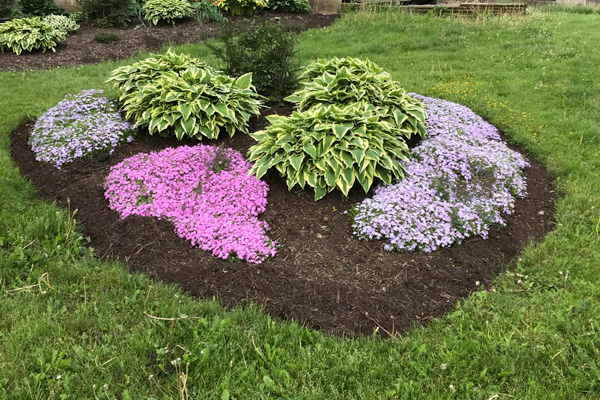Mulching has several benefits, moisture conservation, weed prevention, aesthetics, and erosion reduction. The degree of effectiveness of mulching will depend on the type of mulch used. Two main classes exist, organic and inorganic for your perennial flower and shrub areas.
The most common organic mulch is bark mulch. Bark mulch can come from various wood species, the most common in Nova Scotia is a mixture of spruce and hemlock bark. It is most effective when it is aged enough to bring its Carbon to Nitrogen ratio (C:N) down to about 100:1 and is less sour than fresh bark mulch.
The pH of the bark mulch will be around 5. This is part of the reason it is so effective, its sourness and its low nutrient value make it so that seeds do not germinate in it if they fall on top of it. As well by placing it in a layer 4 inches thick, it prevents many seeds or rhizomes from poking through the mulch by shading them from the light.
The other common organic mulch is dyed wood chip mulch. Its C:N ratio is usually around 300:1 and it has even less nutritional value than bark mulch so it is very inhospitable to seed germinating. It is less acid than bark mulch so its weed prevention is mainly due to the high C:N ratio. It also shades so that most rhizomes or seeds will not come up through the mulch.
The other class of mulch, the inorganic, that is readily available in Nova Scotia is gravel or stone mulch (3/4 to 3 inch clear stone). These do not work as well as the organic mulches, but if placed in a 4 inch layer it can be quite effective on steeper longer slopes where organic mulches can sometimes be eroded in heavy rains.
Many other materials can technically be used as mulch such as pine needles, shredded rubber tire, grass clippings, newspaper, or straw. All of these materials have pitfalls such as supply shortage, poor aesthetics, high erodibility, matting which reduce water infiltration.
My preference is for natural bark mulch, while some may prefer the aesthetics of dyed wood chips. The advantage of the natural is that it is less harsh on the soil, while the dyed mulch can be placed closer to the stems of plants since it is less acid.
I am often asked the question can you mulch in your vegetable garden? You can, but only with material that will not harm the soil so no bark mulch nor wood mulch. Mulching in vegetable gardens is done more for better water infiltration as opposed to weed control there are no real materials that do both effectively in a vegetable garden.
Compost spread on the surface will help with water infiltration, as well as erosion control, but it does little for weed control. Thin layers of grass clippings can be effective for weed control, but can mat and cause rainfall to run of more.
There is magic in gardening, but no magic cure all and it takes more than just waving a wand ☺
To Order Now - Call 902-899-2348
Mon - Fri 8:00am - 5:00pm
(in May & June Open on Saturdays from 9:00 am - 2:00 pm)
Open on Victoria Day weekend from 9:00 am - 4:00 pm Saturday and 9:00 am - 2:00 pm Sunday.
Watch your local flyers for this year's special
Ask us about our contractor pricing!

